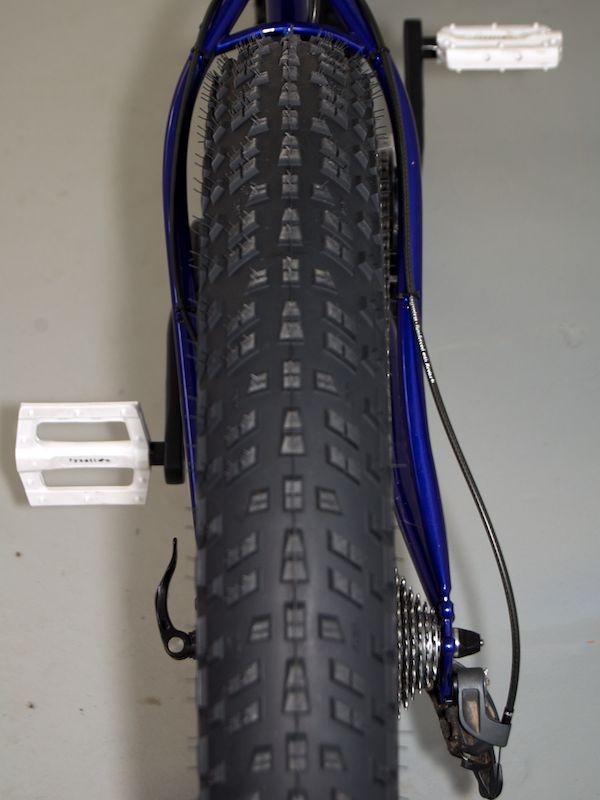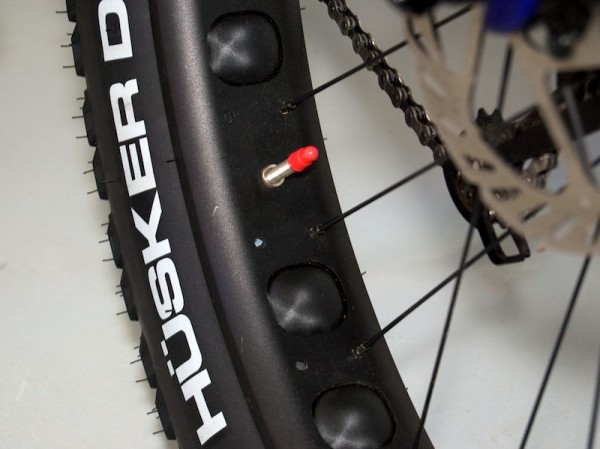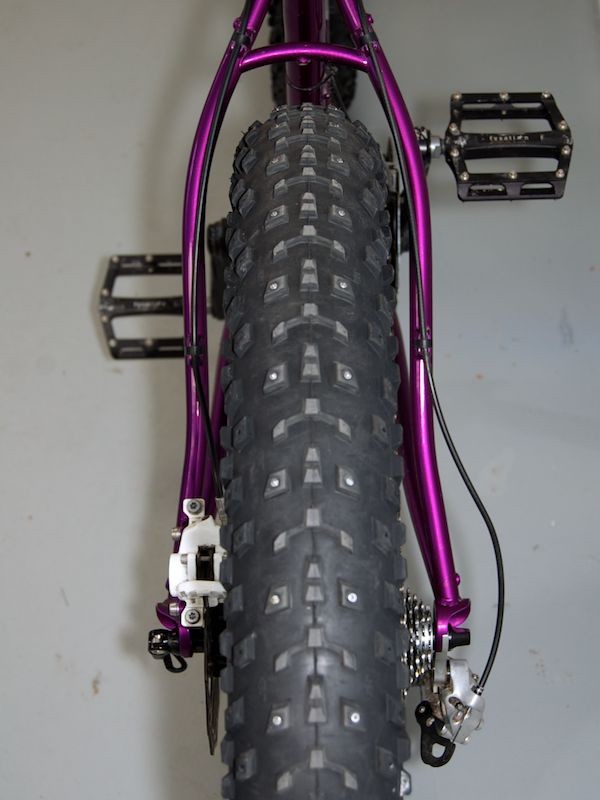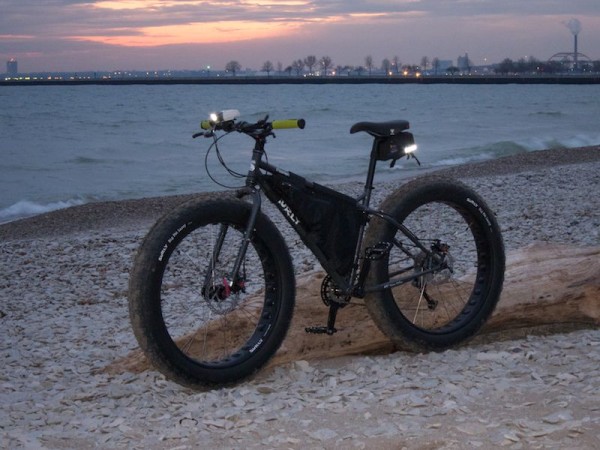This article is part of the Fat-bike 101 series and is intended to help new fat-bike owners, and potential fat-bike owners, with some of the questions they may have about fat-bikes. In addition, it is a chance for experienced riders to add comments to help our new brethren enjoy all that fat-biking offers. Consider these articles as conversation starters, not exhaustive explanations!
Fat-Bike 101 Frame Types
If you go back in history far enough you will find all kinds of unique bike designs trying to solve the same basic problem; how to get fatter tires to work without the chain catching on the rubber! Since this article is not intended as a history lesson we will leave that discussion for another time and, hopefully, from people more qualified to really dig into the root of fat-bikes.
So, that said, fat-bikes have pretty much taken two paths to the solution for getting the mechanical bits around the big tires. They are, in fact, quite similar but with some obvious differences.
Offset fat-bike frames move the rear hub to the right in order for a standard MTB cassette to clear the big tire.
Offset
The tried and true Offset design, like the popular Surly Pugsley, relies on a frame that has the rear end offset 17.5mm to the right to move the cassette/gears out so that when you are running your chain on the little/inner chainring in the front and the big/inner cassette cog on the back that there is still ample clearance for the chain not to rub on that big, whompin’ 26 x 4.0 tire. Now that you’ve moved the hub/gears over you’ve got a wheel that is offset too! Caddywhompus won’t do for a bike that needs to go in a straight line from time to time though. That is why you will find that in order for the center of the wheel to be on the centerline of the bike the wheel must also be built offset; this time to the left to compensate for the right offset of the frame. Very clever and it works quite well at solving the drivetrain problem while also giving you a bike that tracks straight and true.
Fat-bike wheel built offset to the left so it is centered in an offset fat-bike frame.
You may notice that some offset fat-bikes also include an offset fork with the front wheel built on a 135mm single speed rear hub and offset the same 17.5mm. The reasoning here is that fat-bikers tend to go on adventures where there is little to no support and if there is a failure in the rear drive system be it cassette, derailleur or whatever, you could swap wheels end for end and have a single speed drive wheel to get you home.
A major advantage of the offset design is that it uses rear hub axle spacing common to many mountain bikes of 135mm. This gives you a wide range of choices on which rear hub you choose from basic standbys like the Shimano XT to high-zoot hubs like Chris King as well as the most compelling reason to still consider an offset fat-bike, the ability to use an Internally Geared Hub like the Shimano Alfine line, the Rohloff Speedhub or the Nuvinci N360. All use 135mm rear axle spacing.
About IGH
If you are considering an Internally Geared Hub (IGH for short) for your fat-bike you pretty much have to use an offset frame. Salsa tried an adapter system for their 170mm Mukluk a while back but have since dropped the idea from the Mukluk line and we haven’t run across any other workable solutions.
IGHs offer several compelling reason to consider them for your fat-bike drive system including the fact that all the gears are enclosed, there is no derailleur to break off and the ability to use a Gates Carbon Drive belt system instead of the more conventional chain drive. When you consider that many fat-bike owners ride in snowy winter conditions as well as sandy-beach summer conditions IGHs make for a very clean and reliable drive system.
Offset fat-bikes include the Surly Pugsley, 9:0:7 offset and Schlick Northpaw.
Centered in the frame like traditional bikes symmetrical fat-bikes most often use a 170mm hub spacing.
Symmetrical
Referring to a fat-bike as “symmetrical” means that the rear triangle is symmetrical, like most traditional bikes, with equal spacing of the right and left dropouts from the centerline of the frame. Using a conventional 135mm mountain bike hub on a symmetrical frame would not allow the chain to clear the tire in the low-gear range so the space between the rear dropouts needs to be wider. A rear axle spacing of 170mm is the emerging “fat-bike standard” though other rear axle spacings have been used for fat-bikes most often from smaller builders including 165mm, 160mm and 150mm. Originally, available hubs drove this difference as builders adapted hubs from tandems to fat-bikes. The 170mm dimension got a push towards standardization when Fatback owner Greg Matyas began specing them on Fatbacks back in 2008. With the explosion of fat-bikes more hub makers are offering wider hubs and the 170mm width has become the defacto standard for symmetrical fat-bike hubs.
Why 170mm?
A traditional mountain bike rear hub is 135mm and, as stated above, is often used offset 17.5mm to the right on offset frames so to keep the wider spacing on the right but make the rear triangle of the frame symmetrical you’d need to add in 17.5mm to the left side as well so 135mm + 17.5mm +17.5mm gives us the 170mm rear hub!
So why didn’t fat-bikes go Symmetrical from the get-go? There are a couple of reasons why symmetrical fat-bikes did not take the world, immediately, by storm. Lack of available parts was at the top of the list. Only recently have a good selection of 170mm hubs made it possible for frame builders to spec this width hub.
Symmetrical fat-bikes include the Salsa Mukluk Series, 9:0:7, Schlick Tatanka, Fatback, 616 and a host of frames from small builders looking for the ultimate in chain drive performance.
How wide can you go? The Surly Moonlander upped the ante!
Extreme Size
The Surly Moonlander upped the ante even more for the fattest of the fat. Using an extreme offset of 28mm this unique fat-bike was designed to use 26 x 5.0 tires mounted on 100mm rims to give your fat-bike a HUGE footprint and by doing so disperse weight over an even bigger area that “conventional” fat-bikes.
186mm Symmetrical
Finally, some of the Alaskan contingent are working with symmetrical frames again but with an even wider rear hub that measures in at 186mm. This rear triangle spacing allows for a symmetrical rear wheel to be built up with enough clearance to accommodate a 100mm rim, 26 x 5.0 tire, and full 2×10 drivetrain.
What is next?
190mm hubs? Up to 160mm rims? Crystal balls are notoriously mirky but as the fat-biking market matures we should continue to see more choices for frames and components to build your dream fat-bike from. Which one is right for you? Hard to tell, each riders needs are unique but if you want a fat-bike I am sure you will be able to find one that suits your needs.
If you are an experienced fat-biker please consider leaving a comment below to help newbies get maximum enjoyment from their ride.
If you have a topic you’d like for us to open up a dialog on, please send us a note to fatbike101@fat-bike.com and we will do our best to cover it.





Excellent article. Really worth reading and will be a great resource for a long time.
I have a Mukluk 2 with a symetrical rear hub. In terms of what’s next – I’m not sure if hub technology is what’s most needed in the fat bike world. As more of us ride bikes in competition, I suspect carbon frames and racier geometries will become more popular.
I also think front suspension must be on the horizon. Many of us ride our fat bikes all year and I would like to think with 10,000 bikes sold in the last few years, an after market fork would be forthcoming.
Lastly, accessories, accessories, accessories. Heated grips, tubeless tires, etc.
Innovation should run rampant in this market! Go fat!
John, what do you think over all of your Mukluk 2. I also think that symetrical hubs are the way to go. Let me know what you think of your investment – or if you would of taken a different path now. Are you a MTB rider also, or just a fattie rider?
I think that rims on fat bikes for most Midwest riders are getting skinnyer not fatter.
I have a 9:zero:7 frameset that has a 170mm rear hub.
The geometry of that 9:zero:7 frame is much like Niner performance 2 niner frames and…..well I just waited to pull the trigger till something other than Salsa or Surly hit the turf here in the midwest…..
I simply can not say what most fat bike folks want but I know what I wanted in a frame set…..and for now bike frames like 9:zero:7 or fatbikes or Schlick bikes seems to fit what I and many of my pals expect out of a fat bike frame set….
If that carbon Beargrease has the same frame geometry as the muklack or pugsley I would pass…..for racing on anything technical for sure….just my opine on this issue….a few pounds on a bike one way or another does not matter if these frame set issues are not addressed….but I know little about what salsa is doing so its just an opine….
However, said bike industry has employed the racing “hitman” forever in that quest to market said bicycle to the masses….
So as they say buyer beware……
Nine
Nine,
I like the idea that you started your comments with a regional undestandings on tire usage. I am interested in this also. I wouldl think that regions have different bike frame/tire usages, and not one size fits all, but the market could make it easier to understand what to buy for your overall use / region / or intetended use.
I also think that a lot of the voice (comments) out there on fat bikes and thier perfomance is from MTB users verses just pure Fatties. I would like to read more on this, for you Nine, I think you are right if you are trying to use a fattie on a trail in place of a MTB, and or race them, but is that the majority of riders or just a small population of riders, make the change over.
Fatties to me are folks that just want to go anywhere and have fun. I am just a hybrid rider, and use my fattie to take me to more off site location than my current bike – nice and slow, don’t have any ‘mountians’ where I live so my use is much different than yours.
Hope more pipe in on this topic – this is a good site to learn!
Happy riding!
I’m very happy with the 135 off set,I can throw on a set of 29er wheels and have a great utility bike for doing trail work or commuting.
I have to say geometry would make a good article.
My 9:zero:7 handled so poorly I felt sick for having spent so much on it and returned after a couple rides. My Puglsey feels like a mountain bike with ridiculously large tires instead of a ’78 Shwinn Traveler. Maybe a comparison of how head tube anges and rake play to give the handlebar floppy vs twitchy, how chain stay length affects wheelies vs stability, bottom bracket height and perhaps seat tube angle.
Great article, well done.
I’m looking forward to more in this series! I’ve been drooling on my keyboard daily while visiting this site and I’m at the point where it’s no longer a question of ‘if’ I will get a fatty, but ‘when’ I will be getting it and which one will it be! This series and the input of the knowledgable riders on here will certainly be an important part of my decision making process! Keep up the great work!
Thanks for all the comments so far, Folks! We are listening.
The next installment will be a bit on tires. Not only are tires the foundation of all that is fat and have driven the above innovations in frame building but they affect a fat-bike’s performance in several ways! Stay tuned!
I have custom frame that has a 170mm rear hub and 10 мм offset. Best decision for 4,8 tires!
For sure at some stage someone will say, “symmetrical 170, or offset? What about both?” A 170mm offset frame to accommodate even wider rims; it’ll have to be done at some stage. Why? Because we can. No such thing as too fat.
symetrical 135mm frames normaly can’t be geared with derailleurs (but my friend Jean-Marc managed to ride 1×9 with 47mm rims and Vee Rubber mission 26×40), but according to me, it’s the best solution to fit a Rohloff Speedhlub. The chainline is wide enough to fit a Nate/Marge Lite
The result is a really compact bike : short (I managed to reach down to 435mm chainstays), narrow (not to hit the rocks on close corners) and with low Q factor (standard Shimano XT or SLX with 68mm BB works but 83mm BB are a very good alternative to 100mm on these bikes), with a 526% range and no fear to crash your derailleur or break your chain.
Not the best snowbike as Big Fat tires can’t be used, but a very efficient fatbike really designed to ride every kind of tracks (or out of the tracks). Of course, you won’t find a bike like this in your local shop, you’ll have to make it made by a framebuilder. So it will be unique !
Great information here. I’ve seen a couple of “fatties” in bike shops up north but now also several at a local mountain bike race and the idea of one in my garage is growing on me.
The appeal of a fat bike for rooty, rocky, sandy and snowy terrain seems downright obvious.
Can’t wait!
Great article about the frame geometries! I ended up going with the 170 symetrical frame from FatBack and couldn’t be happier. However, I think that 190mm Symetrical will be the new standard for Moonlander type tires.
In terms of versatility this would also seem to be the best option to me. Everything stayes centered with no offset to worry about and just run whatever rim you want to run. I know that BIGGER is BETTER! However, I think that you have to draw the line somewhere and I think that anything wider than a 5 inch tire on a FAT BIKE will be ridiculous. Im probably wrong on this but just my .02 cents!
Getting more than a five inch tire on the bike is probably going to require a wider bottom bracket as well as further offset (or wider hubs). And therein lies the problem, the Bottom Bracket has to be symetrical to the center line of the bike. However, you can also get a larger contact patch on the ground by increasing the diameter of the wheel. A Moonlander 29r for instance, wouldn’t require any rethinking of the chain clearance solutions already built into the current Moonlander frame, you’d simply need a longer chainstay and taller fork. It strikes me that this would be easier than re-engineering the frame/drivetrain to accommodate a wider tire. Then if you think about it, why do you have to stop at 29 inch rims.
I have a 2012 Mukluk II. I have been very disappointed with the drive. I’m rnng a sram nine speed casset that if it gets the least little bit of mung I’m in chain suck city. I could get 150 yards in the NC OBX this summer without grind off the anodized finish. I bought it with en endo morph and have Nards on right now. I ran Nates last winter and had fewer problems with ice and mud than with sand. As long as I keep it pristine it does ok. For the long XC hauls I’m usually using my water bottle as a pressure wash and freewheel spin to just get two our three gears. I’m considering going to XX1 just to try and get the train abit further from the wheelset and tires I’m using.
I’ve been looking into IGHs strumey archer, nuvinci, nexus, rohloff. they seam like the way to go for the knarly stuff. Probably should have thought out my purchase a bit more. Fell in love at a local demo and got one the next month. Been thinking maybe I’ll get chain cleaner that I can pack into my mule witha bit of degreaser and synlube. Whats another pound or so.
Great article–and comments to add to it.
I can say with confidence that a 2014 Beargrease is a superb machine for snow, incline, mud, commuting – maybe it’s the Dillinger tire, maybe it’s the symmetrical frame/hub, could even be the thru-axles making a difference. This is an efficient, fun, agile fat-bike. In the last week I have taken it to four different spots in Colorado, from snow/frozen dirt/ice above Nederland (same at Betasso Preserve) to pristine dry single track near Fort Collins, to mud and snow at Hall Ranch. I think the symmetrical hubs make for a smidge more accuracy on trail, but I could just be infatuated. Compared this against a Krampus, Pugsley, 907. Only thing better would be XX1 for chain line and weight. Totally in love with this.
I am looking to have a custom fatbike built up.
I’m going to be running 100mm Xtreme Fatbike rims laced up to some Fatlab hubs.
I am trying to make a decision on 170 or 190 rear. Skewer axles
This will be a do it all bike but I do plan to keep it light enough to do some racing with it.
Since I am building the frame what are the advantages to going to 190 over the 170?
I have heard some people with 190’s have flex issues with the skewer.
Anyone with some advice before I start welding?
Hi all,
I’m looking to build/buy a fat bike with the lowest possible q-factor. Looking online there are some frame-builders that offer frames limited to 4″ tires on 80mm rims. They still use 170mm rear spacing. Would it be possible to instead run an internal gear hub and use 135mm spacing? Would there be any benefits in terms of q-factor?
Sincerely,
Kyrke
Hello! Please help me choose a high-tensile steel frame for a 26″/4″ fat bike with belt drive. I know it will have a threaded 100mm bottom bracket, and info on the head tube is easily available. I’m only interested in the rear part of the frame because I don’t want to buy the wrong frame and than make adjustments and improvise which add labor time and expenses. Symmetrical or offset, axle spacing, best dropouts style for belt drive, any info will be appreciated. Thank you for your time!
I need to find a fat tire bike (4.5 to 5 inch tires) with a large frame.
I’m a tall guy 6’2″, and 265#s.
I’d like a front suspension, but it’s secondary to the large frame.
Can you suggest who makes larger fat tire bikes and where to buy them?
Thanks,
Dave
http://www.surlybikes.com